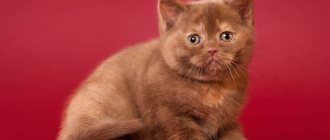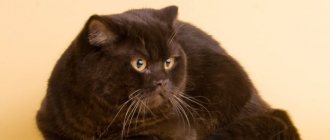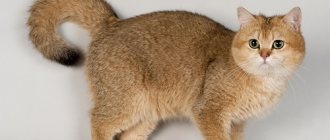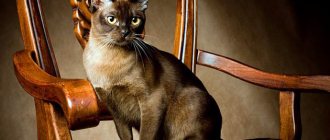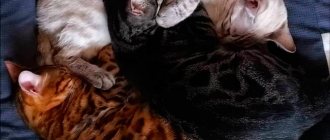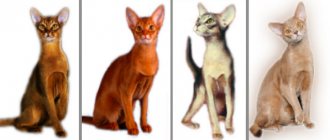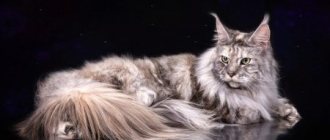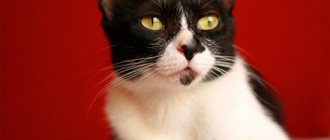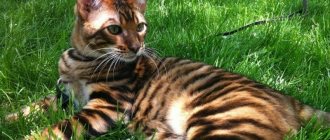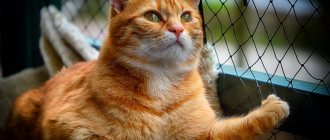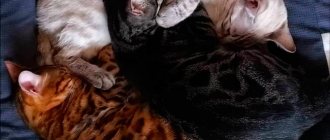The Burmese cat is a breed that was destined to become the queen of the cat world. Extraordinary grace, luxurious fur and eyes the color of precious amber - the Burmese will become not just a pet, but a real living work of art in the house.
In addition to their unique appearance, these cats have a very good character: they are friendly and affectionate, they love when their owner is nearby, and they willingly splash out their feelings on him with a joyful purr. Many other breeds have problems with education, but the Burmese cat is the standard of excellent manners. She will become a true friend and family member.
Colors of Burmese cats
The Burmese cat belongs to the short-haired group.
The appearance of Burmese cats is unique. You can talk a lot about the beauty and strength of the Burmese body, about how, despite its heaviness, it is flexible and good in movement, about the gold of its eyes, about its love for people and high intelligence, but the colors of cats of this breed deserve special attention .
The Burmese cat is distinguished by its special sophistication and subtlety of colors. An important role is played by the Burmese coat: short, thin, without undercoat, tightly fitting to the body. It emphasizes the color and changes the shade at the slightest change in the position of the hairs. The Burmese's coat is shiny, shining with a magnificent "Burmese" sheen.
Burmese cats of all colors exhibit uneven color intensity. The head, paws, tail and back should be somewhat darker. From the back to the belly the color gradually becomes lighter. The neck and chest are also slightly lighter than the main tone. This subtlety of the palette of shades is determined genetically and exists in Burmese cats due to their own “Burmese” gene.
Kittens are born very light. The final color develops as the animal matures. By the way, the texture of the fur itself also undergoes gradual changes and is finally formed, like the color, by two years.
Now let's move on to the description of each color.
Sable
Sable is the most common, the ancestor of the Burmese colors.
This color is not found in any other breed. Sable Burmese comes in different shades. From lighter to richer and darker, from dark chocolate to mahogany. But in any case, it should not look completely black. Although the color darkens a little with age.
With this color, the Burmka looks like a fashionista in an expensive mink coat. The sable Burmese attracts the eye and fascinates with its brilliance. Sables are extraordinarily beautiful and of all colors they have the most shiny, satiny fur.
The main coat color is brown with a slight golden tint, the markings are dark brown, the nose is also brown, and the paw pads may be brown.
Chocolate
Chocolate (champagne) color differs from Sable in the same way as milk chocolate differs from bitter chocolate.
Every year this color wins more and more hearts. Champagne can also have a variety of shades, from light to darker tones, from warm to cooler.
The coat is a warm honey beige color, golden tan and darker points of a beautiful chocolate color. The nose is chocolate. Paw pads are cinnamon or chocolate colored.
The points (darker areas on the face, paws and tail) stand out more brightly on this color than on others and this gives the champagne color an additional advantage.
Blue
The blue color is more reminiscent of steel.
Unfortunately, the color is not fully appreciated, probably because many cat breeds have a blue color. In fact, Burmese have a lighter coloration than the British. And not as lightened at the tips as Russian Blues. Of all the shades of blue, a lighter tone is preferable, but it should not be too cool or have a brown tint. Burmese, with the “correct” blue color, are extremely beautiful, stylish and graceful. They look like an expensive silver figurine. In the sun they shimmer with all shades of silver, and in combination with the gold of the Burmese eyes, they create the impression of unreal divine beings. Blue Burmese are cats for real gourmets and connoisseurs of beauty.
The coat is bluish-gray with a warm tint, the tan marks are beige and the points are dark blue, the nose and paw pads are gray. In this color it is quite difficult to maintain yellow eye color.
Lilac
Lilac is a very delicate light color.
It seems that lilac Burmese are the most affectionate and gentle. These cats are sometimes also called “cougar cats.” Just like other Burmese colors, it can have different shades. But most preferable is light platinum with a delicate pinkish tint. The shade should not be cold and gray... The cat's coat is colored pale-silver with a pink tint, gray, pink-silver tan and pink-lilac points, the nose and paw pads are pink with a lavender tint. Their mask has a slight silver tint.
Red
Red is a gorgeous rich color. The best definition of this color is bright orange. The body is closer to light red. Red seals and cats, like sunbeams, never go unnoticed. They are so bright that they immediately attract your attention and make you fall in love with them. The nose is pink, the paw pads are pink. This color has the brightest amber eyes! Pointing cats often have stripes on their legs and tail. Although now more and more animals are appearing without this disadvantage.
Cream
Creamy bleached red, apricot, more delicate and muted color. The coat is the color of light condensed cream, the tip of the nose and paw pads are pale pink. Tabby pattern on points is allowed.
Burmese cat lilac color
BROWN (BUR n) / SABLE (Sable; BUR n)
Color: Warm dark brown Nose: Brownish-black Paw pads: Brownish-black
CHOCOLATE (BUR b) / CHAMPAGNE (BUR b)
Color: Warm milk chocolate Nose: Chocolate Paw pads: Cinnamon or chocolate
BLUE (Blue; BUR a)
Color: Warm bluish-gray Nose: Bluish-gray Paw pads: Bluish-gray
LILAC (BUR c) / PLATINUM (BUR c)
Color: Light, delicate blue-gray with a slight pink tint Nose: Lilac Paw pads: Lilac
RED (Red; BUR d)
Color: Warm orange Nose: Pink Paw pads: Pink
CREAM (BUR e)
Color: Pastel cream Nose: Pink Paw pads: Pink.
Note: In all colors, the lower part of the body is slightly lighter than the back and limbs. In kittens and young animals, brindle moire and a slightly lighter color of the body are possible. The markings have low contrast and are generally uniform in color. All colors without any stripes or moire.
Burmese are born white and darken as they grow older, so kittens and young animals are sometimes much lighter than adult Burmese.
